
All content & writing by Brad Jaeger © The NACHTKABARETT
More flash expositions and dissections forthcoming.
NK Note: Due to the file names, I am positive that certain animations exist which are not yet hosted here (for example, there is an intro6b, yet no intro6). If you have any missing 'intro' flash animations that are not listed on this page, please contact The NACHTKABARETT. You will be fully credited for your assistance.
 |
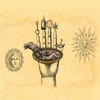 |
 |
 |
 |
| intro | intro2 | intro3 | intro4 | intro5 |
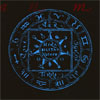 |
 |
 |
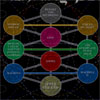 |
 |
| intro5b | intro5c | intro6b | intro8 | intro8b |
| Click each thumbnail above to view the original SmashingPumpkins.com Machina era introductions | ||||

Found in: Intro8 & Intro8b
Description: One of the most sacred and central pillars to the study of Kaballah, along with the Old Testament and the Talmud, is The Zohar. Derived from the Hebrew זהר, meaning "radiance" or "splendor", The Zohar is primarily a late13th, early 14th century text offering a mystical and Kabbalistic commentary on the Torah, generally written in either medieval Aramaic or medieval Hebrew.
The Zohar is a group of books which offer Kabalistic exegesis of the Torah, and examines theological and philosophical metaphysics surrounding the nature of existence, of God, of abstractions such as truth, sacrifice and justice, and on the very nature of morality itself.
The structure of divinity alluded within the Zohar is that of the Sephirothic Tree of Life, which was also employed by The Smashing Pumpkins in the mysticism surrounding and permeating through Machina, most visibly in the very same flash files, Intro8 & Intro8b.
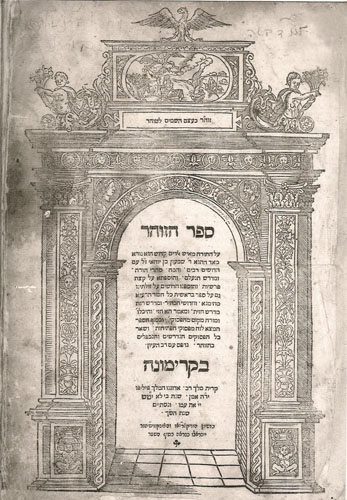 Title page of first edition of the Zohar, Mantua, 1558. Library of Congress.
Title page of first edition of the Zohar, Mantua, 1558. Library of Congress.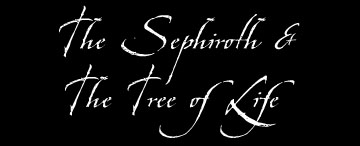
Found in: Intro8 (Tree of life, and all ten names of the sefirot) & 8b (Tree of life only)
Description: The Sephiroth are directly derived from the Jewish mysticism of the Kaballah. The Sephiroth can best be understood as emanations of the Aur Ain Soph (The Limitless Light), often equated with God, or the most perfect creator of all things.
Of the sefirot there are ten, identified on an illustration known as The Tree of Life, which shows the relation and function of the Sephiroth as characteristic emanations of the divine.
- Keter: "The Crown" | Pure and unconquerable light | Complete enlightenment | Union with the divine
- Chokmah: "Wisdom / Revelation" | Insight through intuition | Force of creation | Selflessness
- Binah: "Understanding" | Reasoning | Insight through rationality | Repentance
- Chesed: "Mercy" | Untarnished love | Kindness | Action
- Gevurah: "Strength / Judgment" | Determination | Power | Adherence to the Law
- Tipheret: "Beauty" | Balance | Interconnection | Spirituality
- Netzach: "Victory" | Endurance | Conquering | Tactical
- Hod: "Majesty / Splendour" | Submission | Language | Intellectualism
- Yesod: "Foundation" | Connection | Sexuality | Consciousness
- Malkuth: "The Kingdom" | Material | Earth | Conduit
While not part of the original tradition of Kaballah, Qaballists would eventually write of a non-sefirot called "Da'at": a mystical meeting point of all ten sefirot, unifying the qualities of all, as one. Because of its mysterious characteristics, it came to serve the basis for the soul, and the heart of all esoteric knowledge.
All ten sefirot fell under the guidance of one of three dominant pillars, known as: "The Pillar of Severity", "The Pillar of Balance", and "The Pillar of Mercy". These served as strong foundation of the Cabalistic ideology.
- Left Pillar: "The Pillar of Severity" | Binah, Geburah & Hod | Feminine | Water
- Central Pillar: "The Pillar of Balance" / "Pillar of Mildness" | Kether, Tiphareth, Yesod, Malkuth | Non-Gendered | Air
- Right Pillar: "The Pillar of Mercy" | Chokmah, Chesed & Netzach | Masculine | Fire
Another non traditional addition to the Kaballah was the concept of a mirror image of the Tree of Life (unsurprisingly known as the "Tree of Death"); a result of a great cosmic imbalance. While generally dismissed, great and grand occultists such as Israel Regardie and Aleister Crowley have both entertained the notion of a dark tree in which Samael, Thamiel, Nehemoth, and many other dark forces stir.
The ten Sephiroth find themselves on a four tiered cosmological order; four separate (though connected) planes of existence.
- I – Atziluth: "Emanation" | Domain of the Ain Sof, the Creator
- II – Bri'ah: "Creation" | Without form, and domain of only the greatest of the angels
- III – Yezirah: "Formation" | The abstract and form coincide
- IV – Asiyah: "Action" | The physical world upon which we dwell
I must stress that the Kaballah is not a novelty, nor as simple as I've tried to clarify it. It is an extremely complex, esoteric spiritual art, and should only be undertaken by serious adepts.
It should also be said that the Kaballah has been used in parallel among many other forms of spiritual guidance and divination for the purpose of self gnosis, and enlightenment. It is perhaps most often found in collaboration with numerology, the mystical Hebrew alphabet, and the Scottish Rite of Freemasonry.
A slight elaboration as to why this is the case: interconnected amongst the ten sefirot are a total of twenty-two paths. Twenty-two is a number of some significance to both Hebrew mysticism and the tarot, as there are twenty-two letters of the Hebrew alphabet, and twenty-two major arcane in the tarot.
Thirty-two is found to be another number of Qabbalistic importance. When the twenty-two paths are combined with the ten sefirot, it creates the number of the thirty-two paths of wisdom. It is occasionally associated with 32 degrees of Scottish Rite Freemasonry as well (The 33rd degree being their 'kether').
 |
 |
Above left: The Sephirothic Tree of Life. Note the planetary associations, and the spheres of existence permeating outwards Above right: The Tree of Life, with additional annotations listing the associations with the tarot |
|

Found in:
Intro8 & Intro8bDescription: Portae Lucis (translation: "Gateway of Light") appears as a brief flash of text within Intro8 & Intro8b, as the Sephirothic Tree of Life is being assembled in the foreground. The title is likely referencing two equally significant works: 'Portae Lucis', by Joseph ben Abraham Gikatilla in the early 16th century, and Aleister Crowley's 'Liber Porta Lvcis (sub figura X)' (translation: "The Book of the Gateway of Light"), written in 1907.
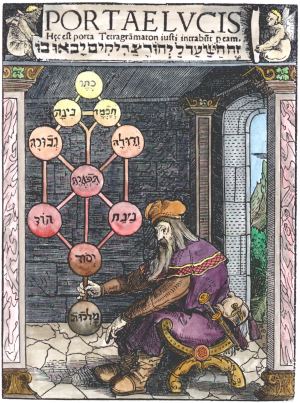 |
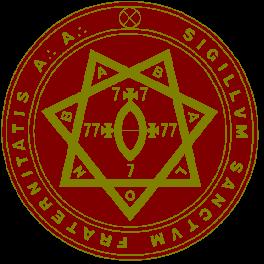 |
Above Left: Portae Lvcis, Joseph ben Abraham Gikatilla, 1516. The cover depicts the Kaballist meditating upon the Tree of Life. This particular image is hand coloured by Adam McLean (link Adam McLean to http://www.alchemywebsite.com/) Above Right: The sigil of Argenteum Astrum; the group founded by Aleister Crowley and George Cecil Jones. The name is derived from the Golden Dawn's Third Order. | |
As previously mentioned, the inclusion may be referencing both the early 16th century alchemical treatise, but also Aleister Crowley, who in 1907 'channeled' through him the spirit which wrote the Class A text in the Holy Books of Thelema for his newly found esoteric order Argenteum Astrum (Silver Star), after the dissolution of the Golden Dawn.
I have hand selected but a few of my personal favourites from this twenty-one verse treatise:
"I who comprehend in myself all the vast and the minute, all the bright and the dark, have mitigated the brilliance of mine unutterable splendour, sending forth V.V.V.V.V. as a ray of my light, as a messenger unto that small dark orb."- Verse II, Liber Porta Lvcis
"This Knowledge is not for all men; few indeed are called, but of these few many are chosen"- Verse IX
"First, there are many and diverse conditions of life upon this earth. In all of these is some seed of sorrow. Who can escape from sickness and from old age and from death? We are come to save our fellows from these things. For there is a life intense with knowledge and extreme bliss which is untouched by any of them."- Verses XI & XII
"To you who yet wander in the Court of the Profane we cannot yet reveal all; but you will easily understand that the religions of the world are but symbols and veils of the Absolute Truth. So also are the philosophies. To the adept, seeing all these things from above, there seems nothing to choose between Buddha and Mohammed, between Atheism and Theism."- Verse XIX
On a third and most basic level, it should be mentionned that Porta Lvcis (Gate of Light) is one of the titles bestowed upon Malkuth, the tenth sefirot on the Tree of Life.
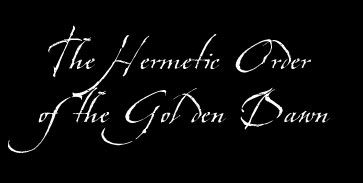

Above: The Rose-Croix; a symbol adopted by The Golden Dawn from the Rosicrucians, and worn by adepts of their inner order. It details: the four elements, the Hebrew alphabet, the hexagram, the pentagram, the Sephirothic Tree of Life, the classical planets, and INRI, among many other subjects. This is just one example of the rich esoteric history of The Golden Dawn.
Found In: Intro8b
Description: Appearing briefly in flashes on each of the ten sefirot, the ten names which are listed: Ipsissimus, Magus, Magister Templi, Adeptus Exemptus, Adeptus Major, Adeptus Minor, Philosophus, Practicus, Theoricus, and Zelator, reference an occult tradition known as The Golden Dawn.
These ten titles of the hierarchy of The Golden Dawn relate to their position on The Tree of Life:
- On the 1st sefirot (Kether): Ipsissimus
- On the 2nd sefirot (Chokmah): Chokmah
- On the 3rd sefirot (Binah): Magister Templi
- On the 4th sefirot (Chesed): Adeptus Exemptus
- On the 5th sefirot (Geburah): Adeptus Major
- On the 6th sefirot (Tiphareth): Adeptus Minor
- On the 7th sefirot (Netzach): Philosophus
- On the 8th sefirot (Hod): Practicus
- On the 9th sefirot (Yesod): Theoricus
- On the 10th sefirot (Malkuth): Zelator
The Hermetic Order of the Golden Dawn remains as one of the (if not, the) greatest influence on the Western tradition of magick, and esotericism. Prominent members, such as: Aleister Crowley and Israel Regardie completely reshaped the very nature of how the occult is perceived and understood in modern culture. Other notable members include some of literature's most sublime writers (Nobel Prize winner for literature, William Butler Yeats, comes to mind), and the creator of the most recognizable monster in literary history (Bram Stoker's "Dracula"). The Golden Dawn would also play a large role in the development of other prominent esoteric fraternities, most notably Thelema.
The Golden Dawn served to develop the spiritual enlightening of its members through beautiful metaphor and allegory. When one studies its tradition, it quickly becomes apparent that The Golden Dawn incorporates significant subjects throughout the ages into a coherent and unified source of wisdom.
My own studies of the Golden Dawn allow me to offer but a shortened list of its many influences:
- The mysticism of early Christianity
- Theology
- Enochian Magick
- Alchemy
- Astral projection
- Tarot
- Theosophy
- Egyptian deism and mysticism
- Numerology
- Freemasonry
- Geomancy
- Biblical parables of the Old and New Testament
- Hermeticism
- Philosophy
- Eastern mysticism (concepts such as 'flux', 'yin-yang' and the 'thing and the unthing')
- Gnosticism
- Rosicrucianism
The Golden Dawn was originally founded in the 19th century by a group of three Freemasons. One of the founding members, William Wynn Westcott, was also a member of another prominent esoteric order of the time, known as The Theosophical Society.
In terms of structure, the Golden Dawn operated in many ways similar to any other Masonic Lodge. One of the key differing factors between The Golden Dawn and Freemasonry however, was that The Golden Dawn structured its hierarchical order around the Qaballah and the Sephirothic Tree of Life, while also opening its doors to female adepts.
The structure and tradition of The Golden Dawn was largely based off of the writing of the original 'Cipher Manuscripts', which detailed the process for grade initiation, ritual, and curriculum study. On these precepts, the first Temple - Isis-Urania Temple- was erected in 1888. This was quickly followed by such other prominent sanctuaries such as the Horus Temple, the Osiris Temple, the Amen-Ra temple and the Abathoor temple. While they prominently flourished throughout most of Europe (particularly in Great Britain), they were also present in New Zealand, and North America as well, by the turn of the 20th century.
The order was historically short-lived however, with nearly all of the Temples closing by the mid 1930's. The last original Temple (the Whare-Ra Temple, located in New Zealand) continued to practice up until its inevitable closure in 1978.
Technically The Golden Dawn is only one the first of the three orders within the organization, although all three orders are commonly referred to under the same name.
The names which appeared in the flash file Intro8b contain the names of the ten titles under the three orders of The Golden Dawn
First Order Grade Structure:
- Zelator
- Theoricus
- Practicus
- Philosophus
These are the four grades within the first order (also known as the outer order), set to intentionally parallel the four Classical Elements (Ignis/Aqva/Terra/Aer | Fire/Water/Earth/Air). A complete understanding of the metaphysics and the philosophy behind the significance of all four of the elements were required in order to advance in teaching. Apart from the elements, there was also a large focus upon the Qaballah, astrology, numerology, the tarot, and geomancy.
Second Order Grade Structure:
- Adeptus Minor
- Adeptus Major
- Adeptus Exemptus
If one managed to pass the examinations, and had a solid grasp on the teachings of the outer order, they became eligible for the teachings of the second order, upon the approval of current second order members.
The second order was formally known as 'Rosae Rubeae et Aurea Crucis' (The Ruby Rose and Cross of Gold). In addition to their own required readings and responsibilities, the second order was also placed with the task of governing and overlooking the first order.
In terms of specific teaching, the second order was far more focused on magick. It was not uncommon for a Temple to teach: scrying, Enochian magick, astral travel and astral projection, and summoning & banishing rituals. The Rosae Rubeae et Aurea Crucis also placed a far greater significance on the role of alchemy.
Third Order Grade Structure:
- Magister Templi
- Magus
- Ipsissimus
The third order, also informally dubbed the "invisible order" (for obvious reasons), were comprised of a select group of 'secret chiefs'; adepts who had transcended the material, and who were now immaterial, existing on the astral plane in ethereal form. Communication was only possible through select means of ritual to members of the second order. The secret chiefs served as everlasting archetypes and symbols of an enlightened mind and spiritual leader.
Sadly, the Golden Dawn in its original form cannot be found today, despite the sinister plethora of profiteering enterprises in its name.


Found In: Intro5b
Description: Appearing prominently within the first few seconds of the animation. The image is taken from a 17th century illustration, by M. Maier.
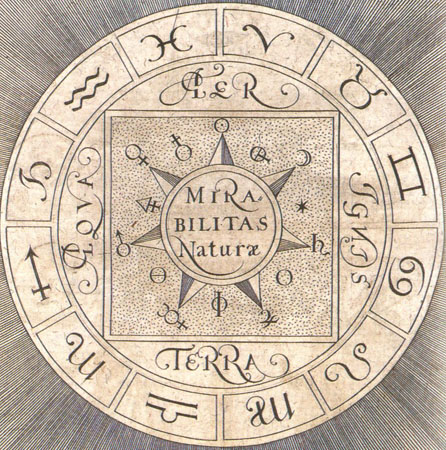
Above: A seven pointed star; each point labeled with its classical planet / chemical substance. Surrounding it are the four classical elements (Aer/Air | Ignis/Fire | Terra/Earth | Aqva/Water), which are themselves encircled by all twelve signs of the zodiac. The center reads “Mira Bilitas Naturae” (“The miraculous ability of nature”).M. Maier, Viatorium, Oppenheim, 1618

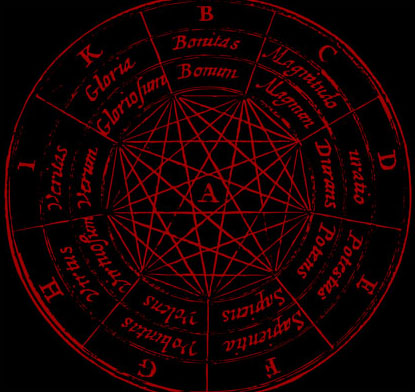
Found In: intro5b
Description: Appearing a brief second after the “Mira Bilitas Naturae” image is a combinatory figure created by Ramon Llull (1232 – 1315). Ramon, who was a Christian mystic, was outspoken in his position against the occult and the alchemical, while still managing to secure their interest. This may be on account of his attempt at creating a tool for the purpose of highlighting universal truths through logistical means.
However, Ramon was concerned with more than just the truth behind metaphysics – he was also bent on converting and recruiting the “sterile souls” to his cause, and saw his tool as being an integral part of rationally showing others the fault in their dissenting views, while securing the validity of his.
The image derives from his work, Ars Magna (The Great Art).
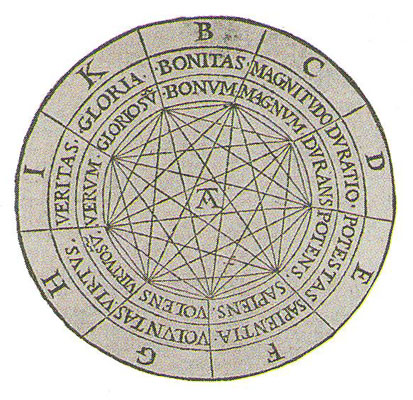
Above: This particular combinatory figure from Ars Magna was an attempt to show how Christian doctrines could be found highlighted in a set of basic ideals and values. When one accepted his basic premises on the nature of God (which was arranged in such a manner as to appeal to all monotheisms), it enabled Ramon to gain solid footing from which he could advance his arguments.
The process was illuminated by the interconnection between the letters, words, and lines. This was an attempt of creating a logistic and rationale wheel for advancing the argument of certain metaphysical concepts.
Ramon clarifies,
The alphabet must be known by heart, as without it the artist has no way of putting this art to practical use. It is included in this art in order to signify the principles and questions whose content serves to solve problems at hand with true intellectual certitude removed from any doubt.
Translating the Latin, in this figure we have:
- B | Bonitas | Goodness
- C | Magnitvdo | Greatness
- D | Dvration | Duration
- E | Potestas | Power
- F| Sapientia | Wisdom
- G| Volvntas | Will
- H| Virtvs | Virtue
- I | Veritas | Truth
- K | Gloria | Glory
Ramon’s system is certainly not notable for simplicity. For those who intrigued by this system, and wish to explore the Ars Magna further, click here.
